A new era dawns at Barcelona. The La Liga titans have lost Lionel Messi, the best player in the club’s history and perhaps, as some would argue, the best player of all time. While the immediate reactions may be negative, there is a world in which the Argentine’s transfer to Paris Saint-Germain ends up helping the club in the long run.
This tactical analysis will look at three crucial aspects Barcelona can improve on without their talisman. We’ll go through some of the tactics Ronald Koeman may want to implement now that his system will not depend on a single entity, even if that entity is the best player in the history of this sport.
We’ll divide the analysis and scout report into three major parts, dissecting flexibility & fluidity, verticality & width and pressing/counter-pressing & rest defence. So, how should Barcelona adapt to the pot-Messi era?
Let’s find out.
Flexibility & fluidity
One of the main takeaways from Barcelona’s first official game in La Liga against Real Sociedad was the mobile and rather flexible approach of their front three. Martin Braithwaite, Memphis Depay and Antoine Griezmann interchanged their positions regularly, all three fulfilling different roles in attack. But even more importantly, they complemented each other rather well.
I’ve already touched upon that topic in my tactical analysis of that same game against La Real. Below, you can see a touch map of all three players which can tell us more about this fluid approach.
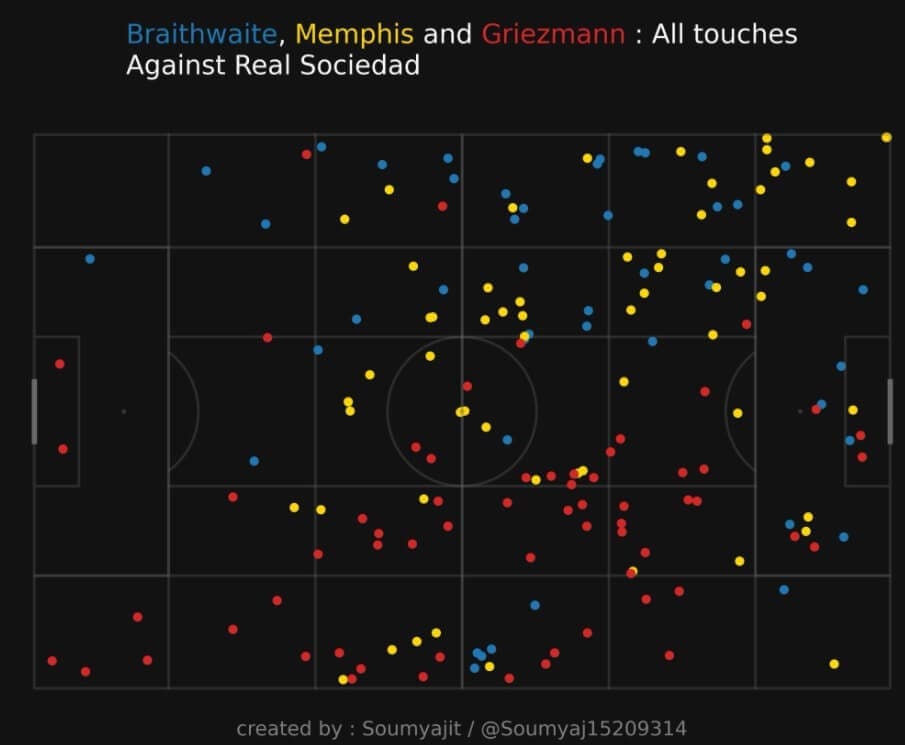
This gives us a taste of their actions across the pitch. We can see that all of them have preferred areas of operation and clearly defined roles but also certain freedom of movement depending on their teammates’ actions. Memphis was the team’s centre-forward but everything ran through him. He would drop deeper when necessary and offer runs when the system needed him to.
In fact, a very similar thing can be said of all three. All three provided Barcelona with a presence in the box, a deeper link-up option and a wide entity that attacked space. But most of all, notice how there’s a lot of interchange between all three. A quick look at their respective heatmaps below will tell us a bit more.
Again, we can see some familiar features. All three players are essentially free across the final third and all three register touches in the box.
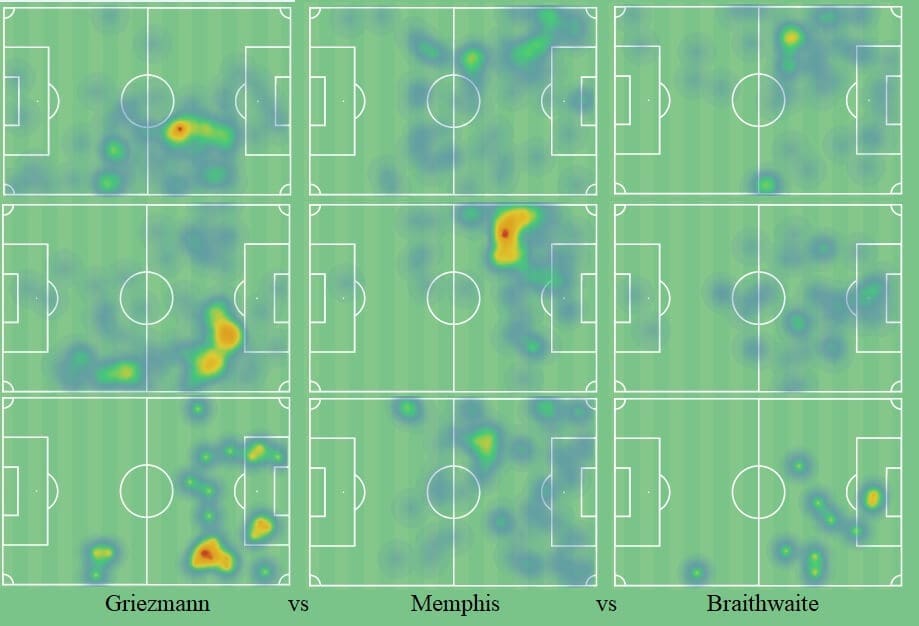
Of course, there are differences in their movement too. Memphis has been predominantly used on the left and that’s generally where he’ll gravitate towards even when deployed as the team’s centre-forward. Griezmann is most active in the right half-space. Intriguingly, that’s the area usually occupies by Messi and one that’s been off-limits for the Frenchman.
With Leo gone, Griezmann is much closer to his preferred area of operation. Braithwaite, on the other hand, is the only natural striker of the three, albeit with some uncommon tendencies for a centre-forward. Koeman has used him in a quasi-winger role of sorts, hugging the touchline and making constant runs.
But of the three, he’s the one with the clearest six-yard box presence and there lies his predominant role. Looking at the territory map below, we can see their involvement again. The areas highlighted show us the players’ zones of operation with darker colours indicating a greater impact on the attacking phase.
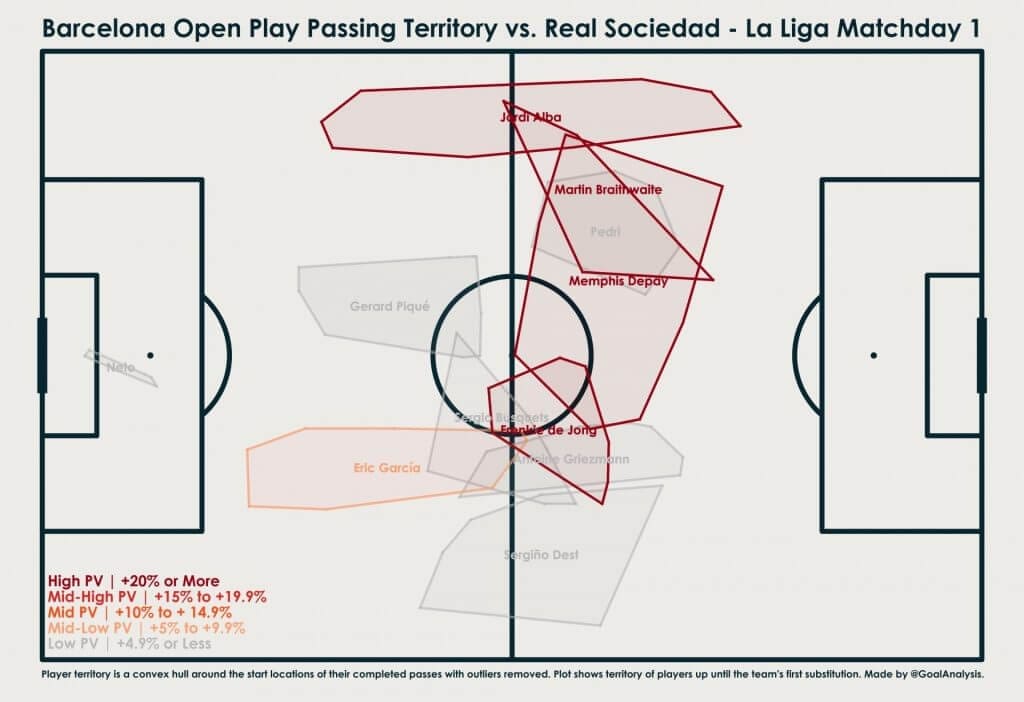
It’s difficult to look past Memphis’ incredible influence but what is most interesting is how the touches were spread across the team. Jordi Alba is the one leading the line with a total of 36, followed by Depay’s 29. For comparison’s sake, Messi averaged 52 per 90 minutes last season.
Quite clearly, with a slight caveat of only a single game played in LaLiga at the moment of writing, the trend might be shifting and the responsibilities shouldered by multiple players instead of one. We already know that Messi was the system at Barcelona and everything went through him. And while arguably, surrounding him with runners on each flank could’ve done the trick, he himself not being a runner complicated things.
Barcelona were predictable because only Messi had the freedom to drop and ping passes into other players. Should Griezmann do the same, it eliminates one potential runner up front. The same would’ve been true had Memphis done it in an imaginary scenario where both him and Messi are at the club.
But with the added flexibility of a forward line made of runners and playmakers, this changes everything. Such a trend was visible throughout pre-season and the La Liga opener. Let’s look at it below.
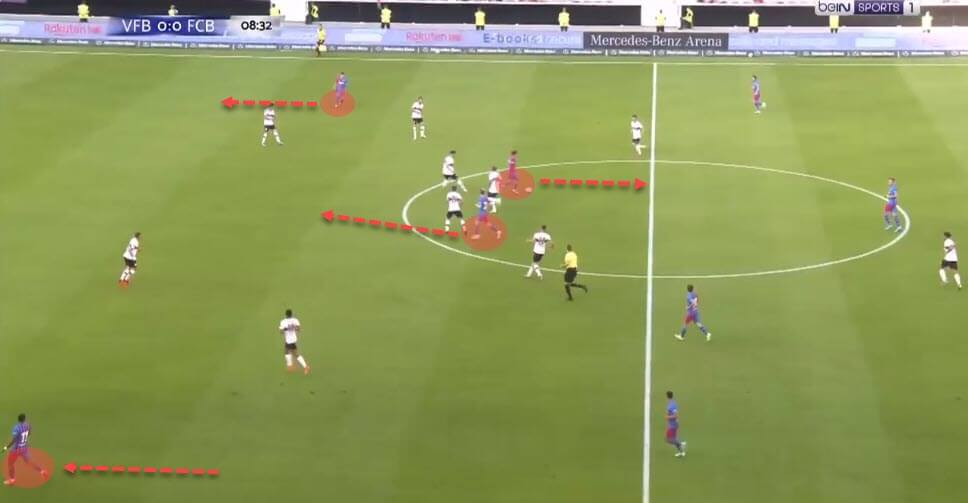
Against Stuttgart, we constantly saw one of the front three drop deeper for link-up. In the image above that’s Griezmann as the Frenchman looks to combine with the midfield. However, what’s important here is the ‘like-for-like’ replacement. A dropping player who’s also a runner is replaced by another willing runner from the deep.
At the same time, we can see the structure remains intact as Barcelona still have width and runners ready alongside the one coming from the deeper areas. This means they’re disciplined and flexible at the same time, which is something that wouldn’t be possible with Messi in the team. Again we come back to the problem of predictability.
Messi was often replaced by a runner from midfield himself. Think of his relationship with Arturo Vidal, Paulinho or Frenkie de Jong. However, as soon as someone else is doing the same, the structure and the efficiency of attack suffer.
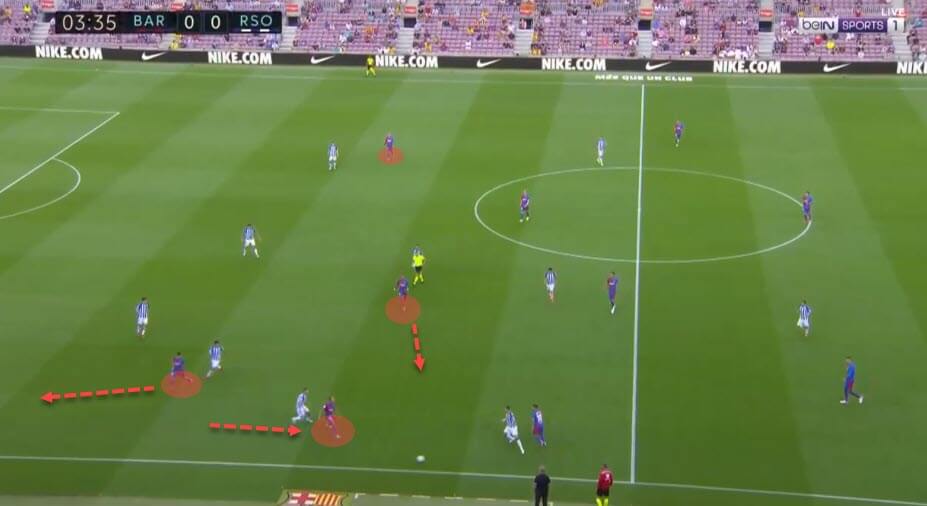
The above image against Real Sociedad is another good example. Here, we see both Braithwaite and Memphis gravitate towards the ball but Barcelona still have runners positioned high and wide on the pitch. With Messi, this becomes much more difficult because you either play him in the false nine role with two wingers or you rely on full-backs for width.
This is not to say that Barcelona will no longer utilise attacking full-backs. On the contrary, Alba has already shown us that he will continue bombarding forward when the opportunity presents itself. However, having an inverted winger on the right in Griezmann changes the complexity of the system once again.
Messi’s starting position is usually on the right but while he drops either centrally or deep, Griezmann will do the same but also offer a darting run through the half-space and into the final third.
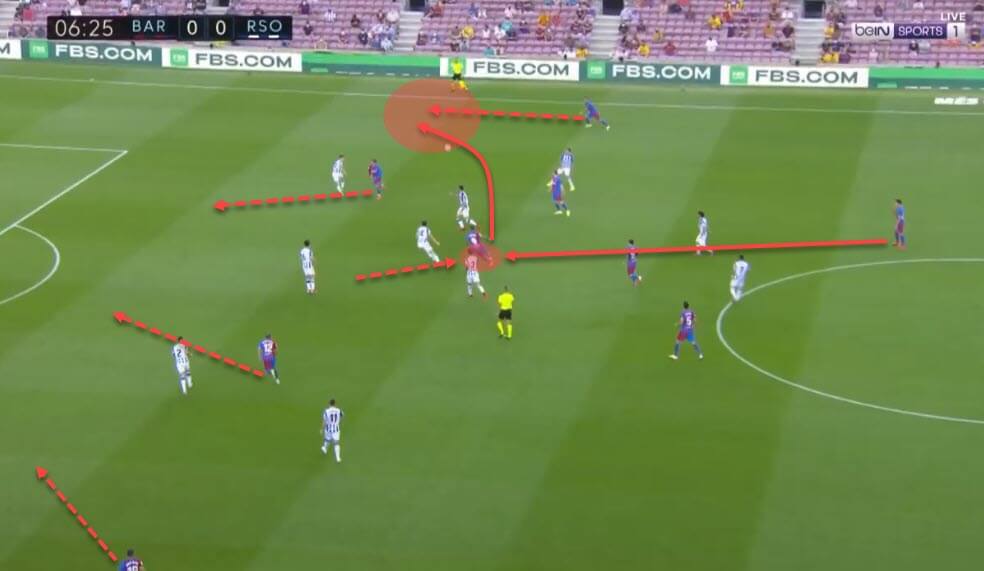
Above we can see how Griezmann’s movement drags the markers away and creates space for the full-back to overlap. At the same time, he offers an outlet centrally as well as an additional runner. Memphis can act as the lay-off striker, as can be seen above, but will then rapidly change directions and still bombard towards the box.
This means Barcelona are much vertical in their approach and still have the necessary width to create and exploit space. The next section of our tactical analysis will deal with exactly that.
Verticality & width
One of the biggest issues Barcelona faced in recent years has been the lack of verticality and width. With the majority of their players, including Messi, being ball-dominant players who didn’t attack space, the Catalans’ attack was becoming blunt. Of course, Messi was still Messi and for that reason, their numbers were still good. However, that didn’t solve the underlying issues.
They were overly dependant on him and the lack of width made them a fairly easy puzzle to solve. Teams would often turtle up and shut down all central passing channels, banking on Barcelona not being able to break through them down the flanks.
The graph below shows us their attacking tendencies with and without Messi from 2020/21.
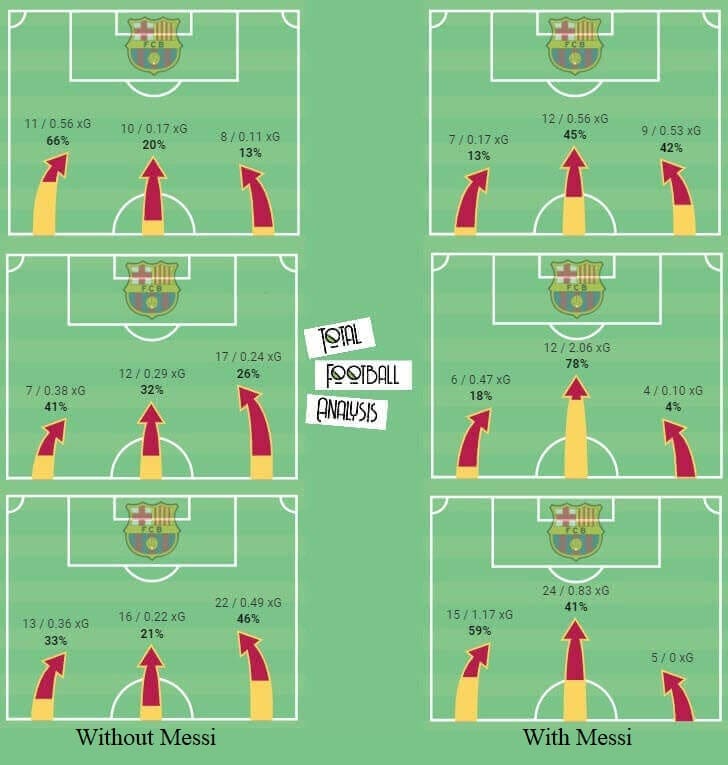
We can clearly see that with Messi, Barcelona are more central while without him, they utilise the wings more. The reason behind that is simple, Messi is not a winger and replacing him with a player of such profile changes the system. Even in the limited sample of games without him, the pattern was clear – Barcelona were far more vertical, quicker and stretched the pitch better.
When one of the players dropped deep to receive the ball, others were always holding the structure, providing width and threatening runs. This image from the game against Real Sociedad is a clear example of such a system.
Memphis has dropped deep but both Braithwaite and Griezmann are occupying the backline and are positioned wide on their respective flanks.
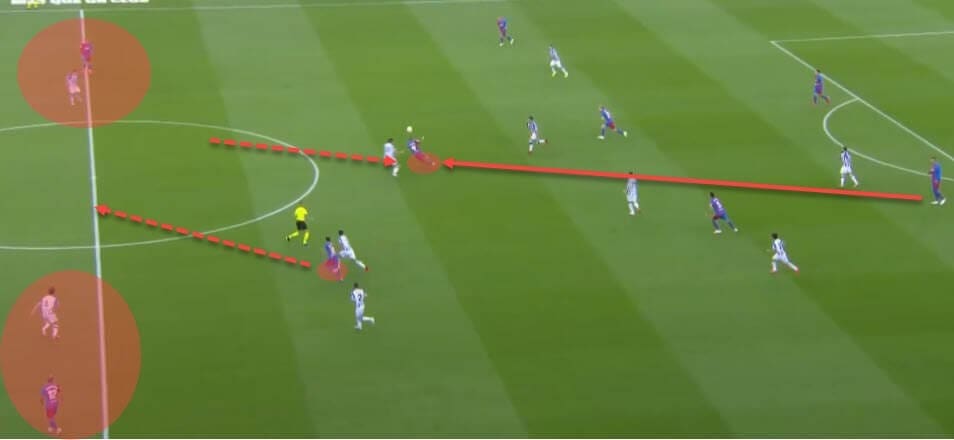
And once more, alongside the two forwards keeping the width, we have the ‘like-for-like’ replacement for the dropping player too. This ensures Barcelona always have a presence high up the pitch and an outlet to aim for that will attack space. Even more importantly, this has been a constant feature across their recent games without Messi, which could suggest that it’ll be a trend throughout the season too.
Simply having three forwards who attack space but also have the ability to link up deeper makes all the difference in their approach. Below we see another great example of this. Memphis is the one dropping deeper again and when he turns to deploy a long ball into the final third, he finds there are a plethora of runners to aim for.
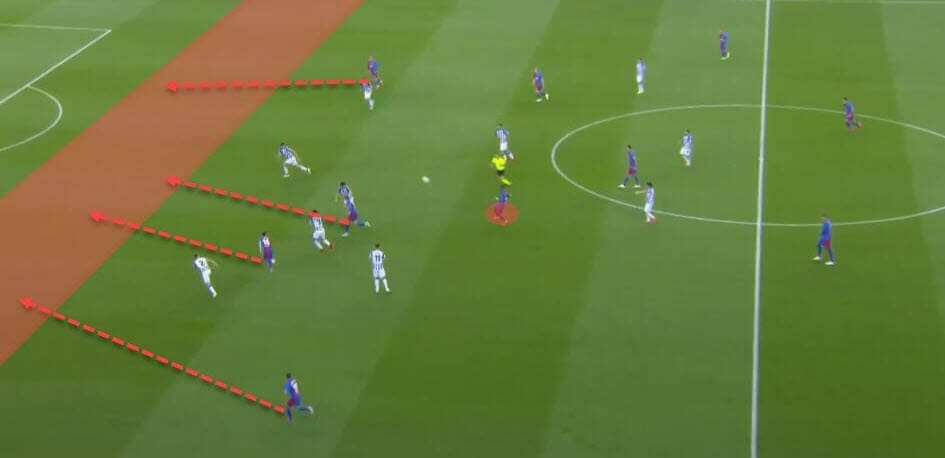
If we compare that to the single target Messi had in Alba, the difference is staggering. Admittedly, this is not exclusively due to the Argentine’s presence. Barcelona would get a similar effect had they just surrounded Messi with the right profiles but there’s also the constant theme of banking on the very same approach week in, week out that would still be the issue.
This new structure that consists of entirely different profiles seems to have a higher ceiling in the long run. But it also ensures one more thing – easier central penetration. By having big wide presences, Barcelona can effectively stretch the opposition’s backline, creating space centrally too.
You can see an example of that below with the action that led to an early goal for the Catalans against Juventus.
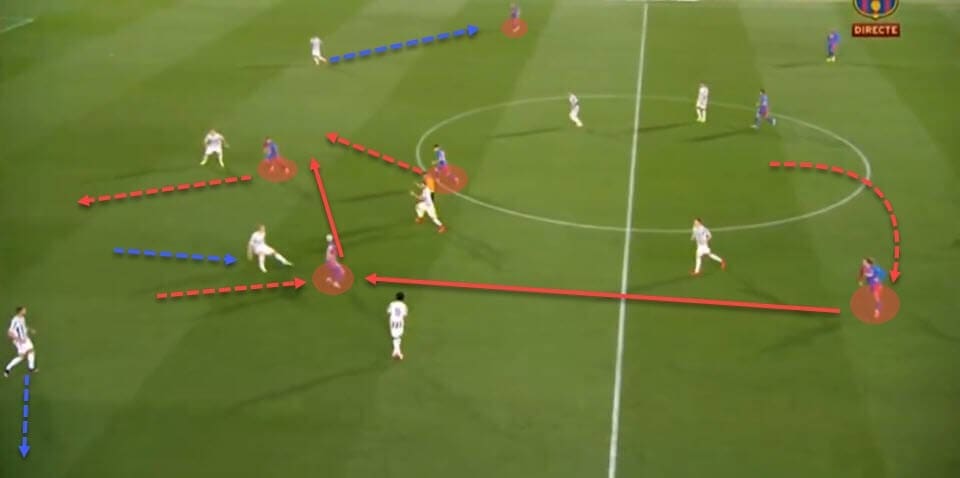
By having two extreme width providers, Barcelona have stretched Juventus’ backline, creating space for the two central players to combine. Griezmann drops and is immediately replaced by a runner and Memphis is the second one to attack space too. With their backline stretched and multiple players surging forward, Juventus can do nothing but watch as the Dutchman rattles the inside of their net.
Finally, when it comes to verticality, we have to mention transitions. Again, keep in mind the sample is still fairly small but Barcelona have seemed more efficient in their attacking transitions. Once more, the key here is to always have available outlets to aim for in such situations.
In recent years, that was far from being the case. Usually, a lonely Luis Suárez would sit isolated in the opposition’s half while Messi would only have Alba to aim for. Now, Barcelona can break with far more pace and intent.
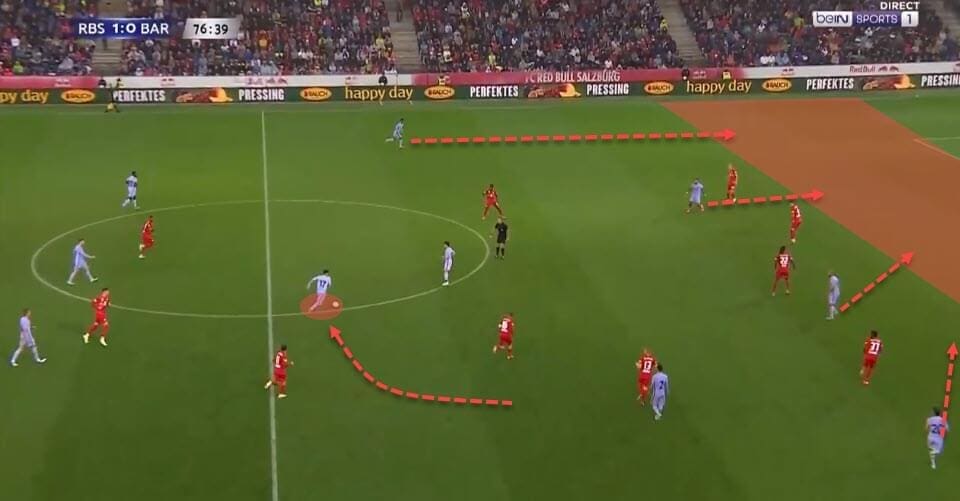
Above, you can see the Catalans transitioning through Yusuf Demir against RB Salzburg. Clearly, when two forwards who attack space are joined by two marauding full-backs, Barcelona will have no shortage of targets in the final third.
However, what about situations in which they are being countered? How will Messi’s departure affect their defensive style of play?
Pressing & rest defence
The final part of our tactical analysis deals with a very important aspect of Barcelona’s recent downfall. Even though pressing and counter-pressing has been a part of their identity, it has become less effective as of late. It goes without saying that without Messi, they might be far more aggressive in their pressures and off the ball movement.
Statistically, looking at their numbers in 2020/21, without Messi Barcelona have recorded far lower PPDA numbers, decreasing to 8.77 from 11.76. Similarly, they’ve recorded more defensive duels (61.33 per 90 compared to 57.5), recoveries (87 compared to 70.5) and fouls (10.83 compared to 9.73).
But Messi’s departure seems to be having a somewhat different change too, one which goes beyond the numbers; it’s bringing about a change in structure. Without him, as we’ve mentioned, Barcelona are once again respecting the principles of width and depth, thus occupying the flanks more often. This has aided their attacking phase, sure, but it also, for now at least, means their full-backs are somewhat more conservative.
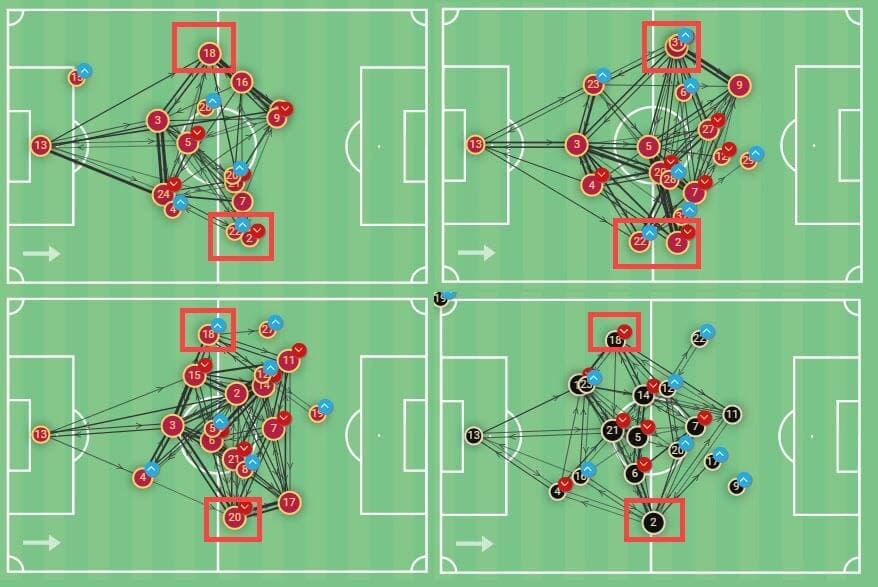
While the change might not be as drastic in the passmaps above, it does seem both full-backs are staying slightly deeper in possession. Of course, both will still bombard forward, especially Alba, but only when a clear opportunity presents itself. This is bound to bring about a change in their defensive structure, especially in their rest defence.
Up until this point, Barcelona’s rest defence comprised of only the centre-backs and Sergio Busquets, tasking the veteran midfielder to cover the entire width of the pitch at times. This was necessary because Barcelona needed runners and width, thus deploying both full-backs and often De Jong high up the pitch.
Now, however, with enough runners and width, the full-backs can be more conservative in possession and De Jong can assist Busquets in the rest defence. We can see a similar example below.
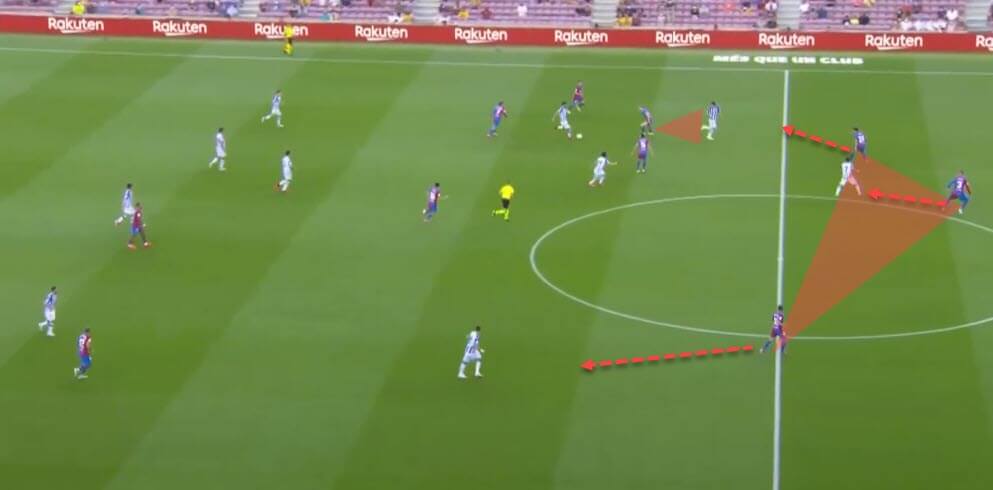
Alba drops deeper to protect the backline alongside Gerard Piqué and Eric García while Busquets is joined by De Jong as the protection just ahead of them. One of the basic premises behind a good rest defence is achieving superiority or at the very least, matching the opposition players behind the ball.
By allowing the full-backs and, if necessary, an additional midfielder to stay deeper while not losing an output further up, Barcelona may have found a more stable formula for this to work. Let’s look at a couple more examples.
Here, against Juventus, we see both full-backs, the centre-back duo and Busquets covering the transition and providing sufficient backup to at least stave off the attack.
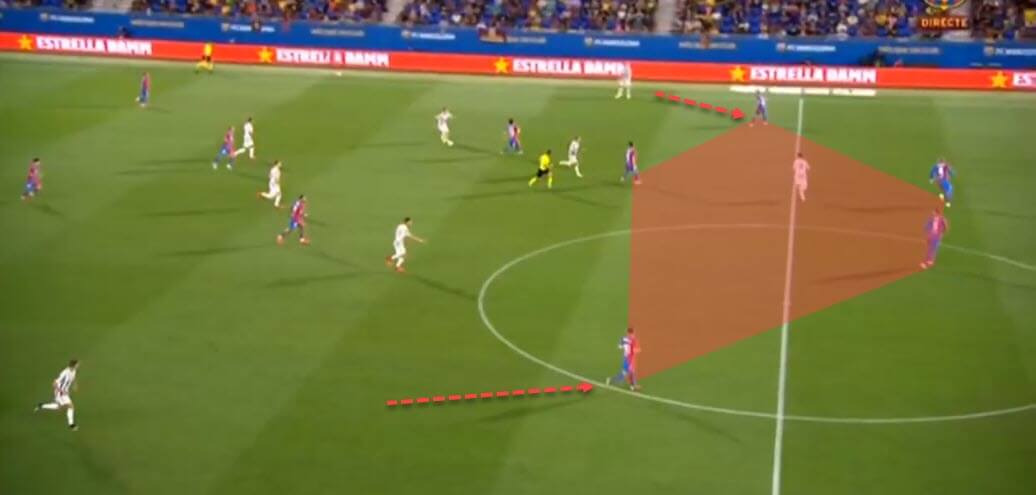
It’s also important to note the willingness of forwards to track back, which wasn’t always the case for Barcelona. This plays a major part in the whole story as well. But it’s the attacking structure that enables a good rest defence.
By positioning their forwards wide, they allow the full-backs to be more conservative without affecting the attacking capacity too much. Another example below shows us this perfectly.
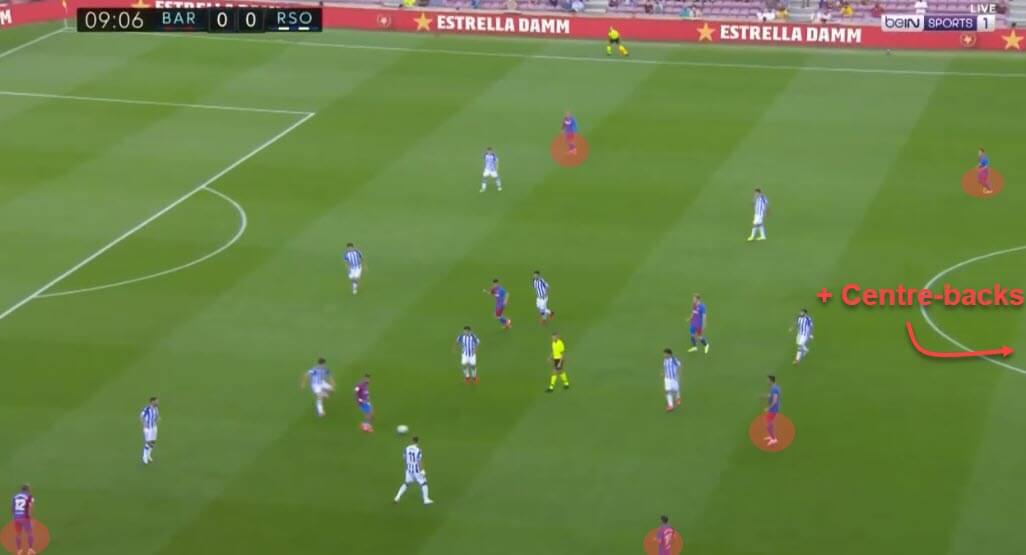
A rest defence of at least five players deep behind the ball is something we’ve rarely seen practised at Barcelona and while we’re yet to see how effective it’ll be, in theory, this is already an improvement.
But a better structure in possession also means a better structure for counter-pressing. By occupying the right zones across the pitch, the players can successfully cut off certain passing channels just by being present. In the example below, the forward line not only stretches the backline, preventing them from just turtling up and keeping close distances between their players but also prevents a switch to the other side.
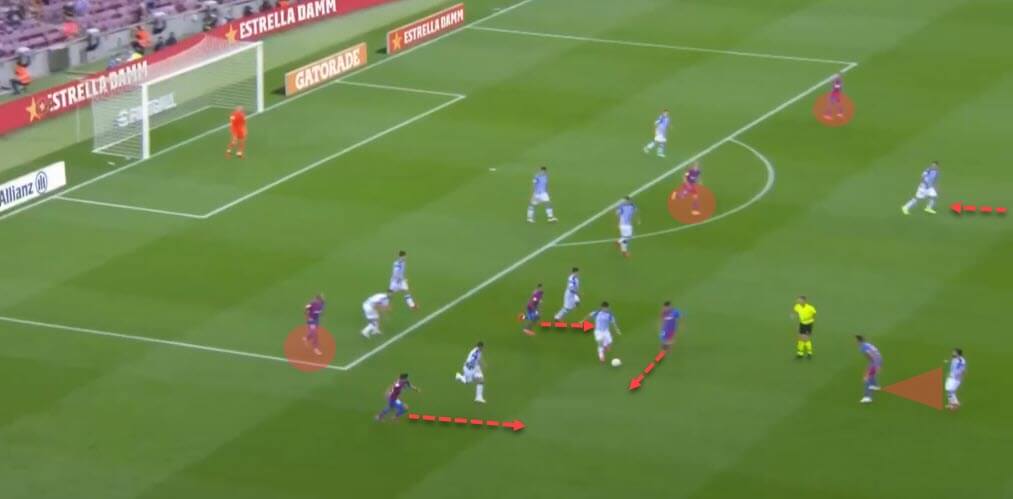
And then there’s again that work-rate that now comes from all three lines when counter-pressing the opponent. We’ve seen it throughout Barcelona’s pre-season and in their first game against La Real. When they press as a unit and everyone is involved, it becomes much easier to deal with the opposition.
Of course, the primary function of a counter-press is always to win the ball back as soon as possible and preferably in dangerous areas but stopping the transition is also one of its goals. In the following example, even though they don’t reclaim possession, the Catalans still successfully stop Juventus from counter-attacking.
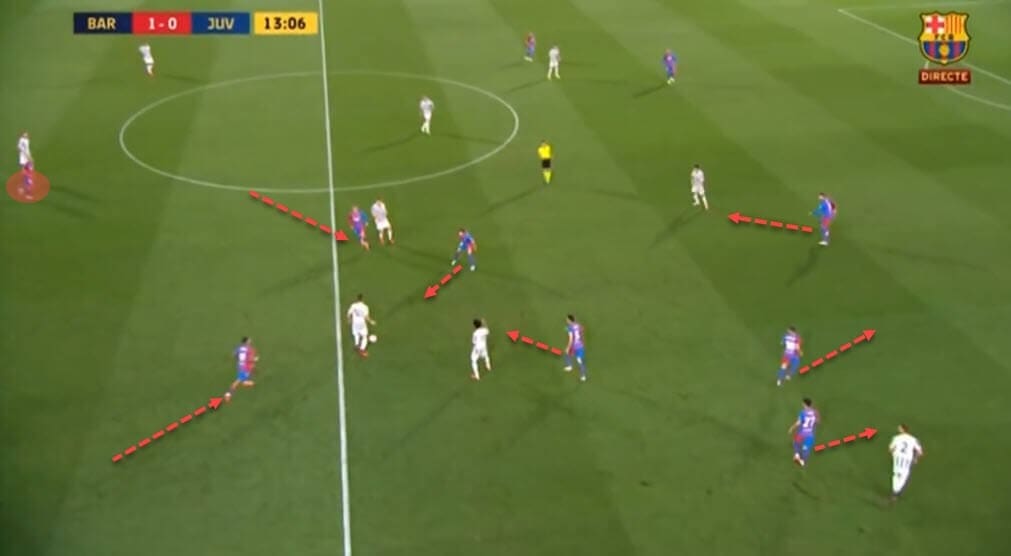
It’s still early to make a verdict but they seem to be moving in the right direction.
Conclusion
There’s bound to be some teething issues as Barcelona start a brand new era at the club. Life after Messi will be difficult at first but in time, as soon as they adapt, this team should be able to rediscover the things that made them special in the first place.
It may be hard to believe but if they play their cards right, Barcelona could even prosper from Messi’s departure in the long run. It’s just a matter of getting over the heartbreak and the disappointment that still echoes the Camp Nou.

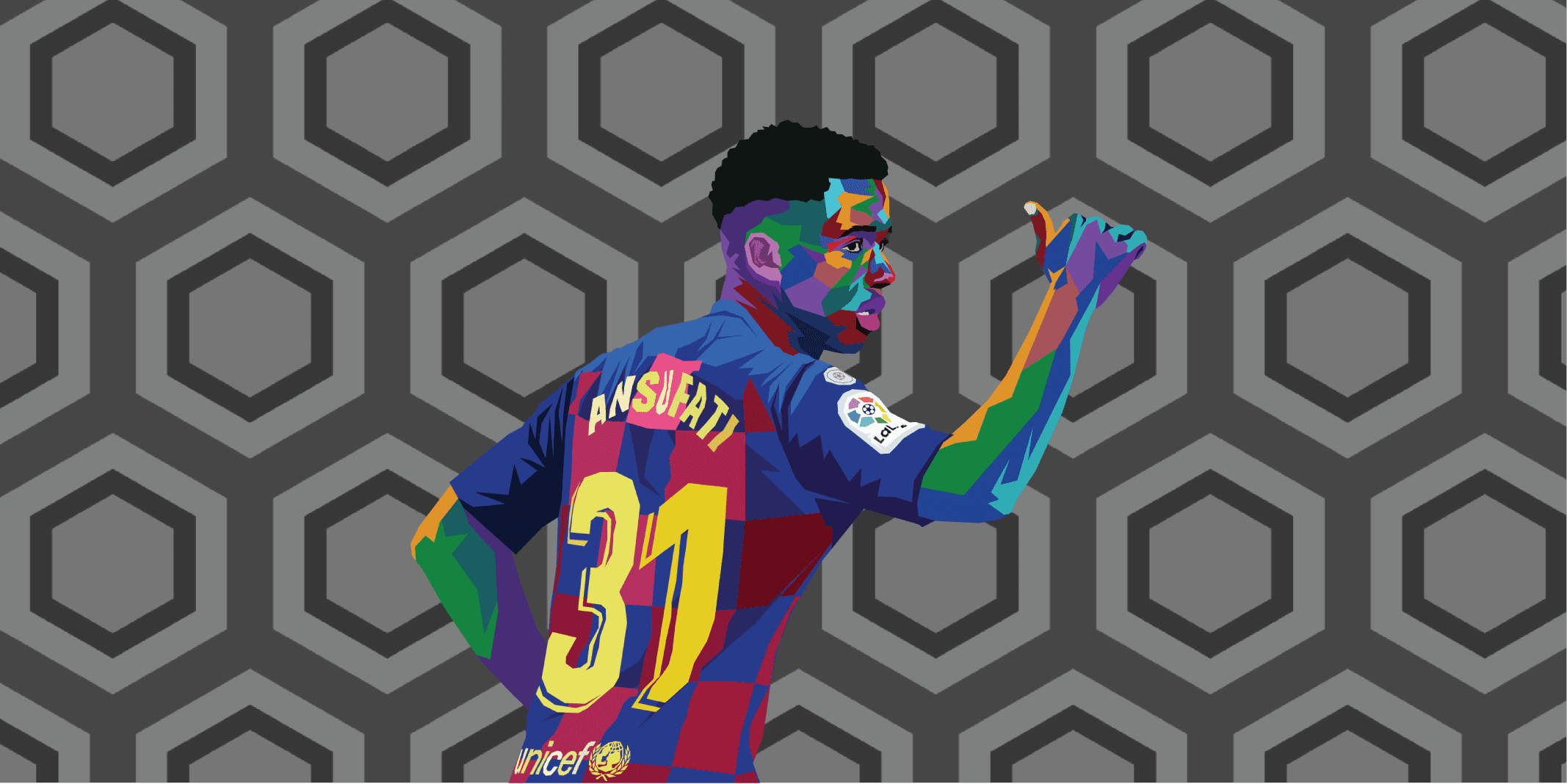




Comments